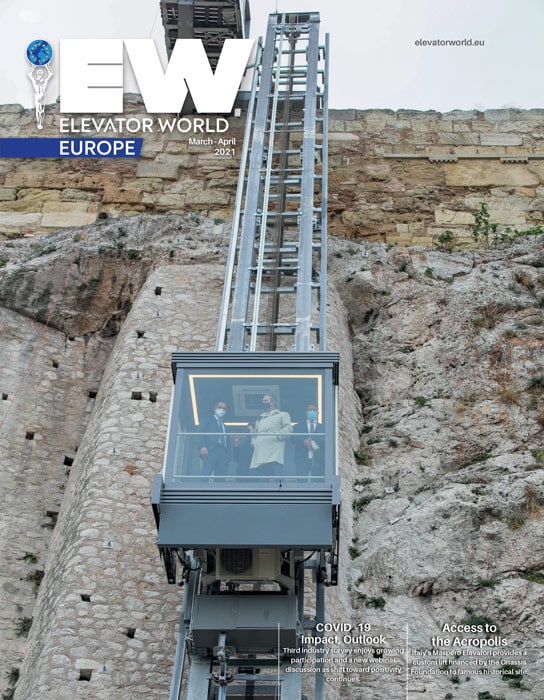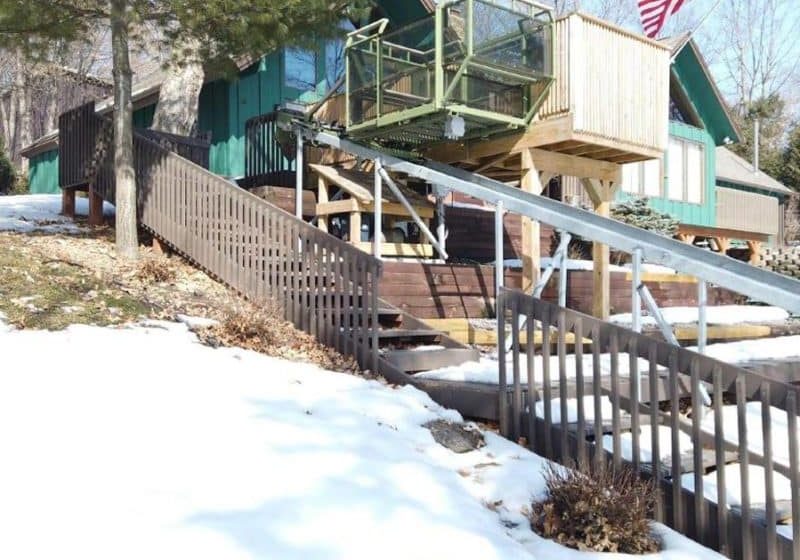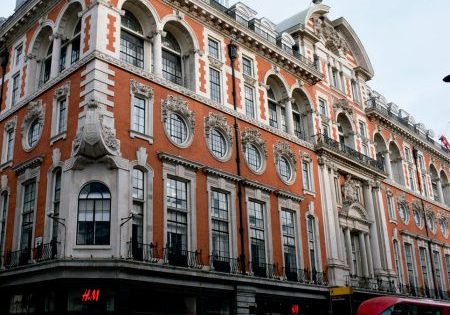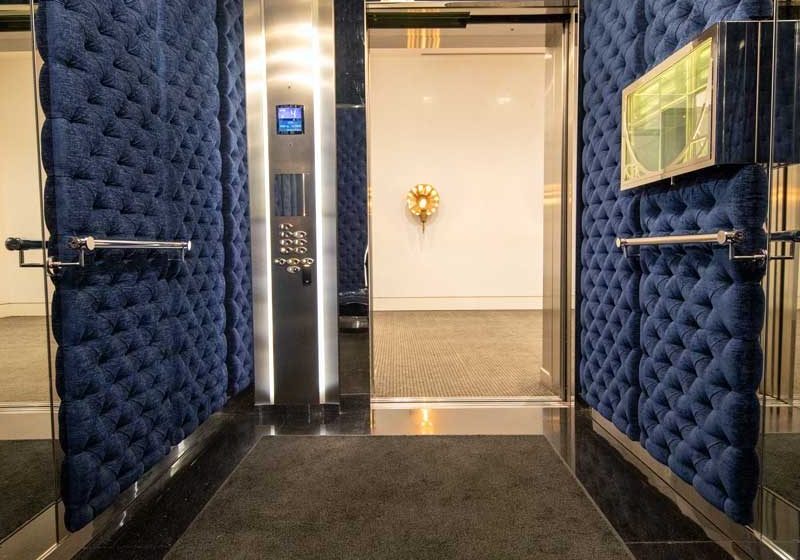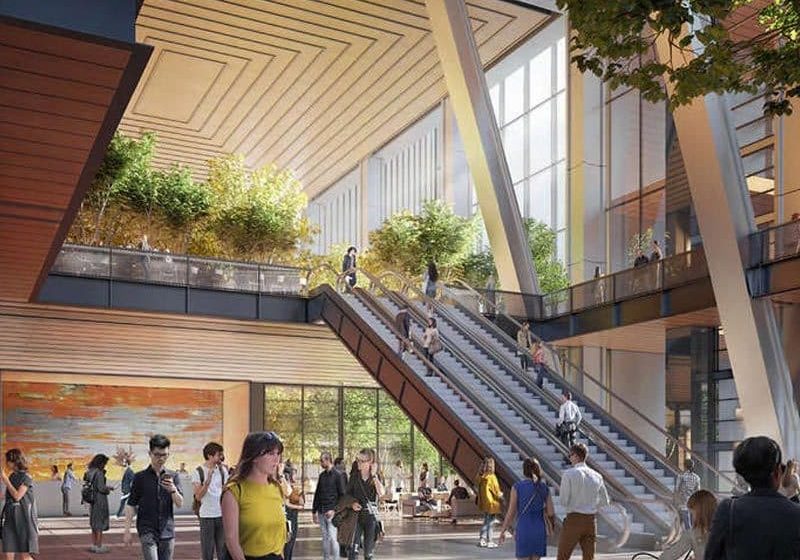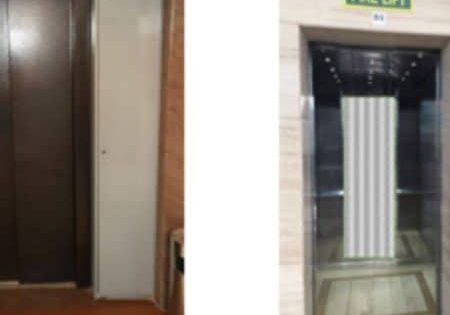Access to the Acropolis
May 1, 2021

Italy’s Maspero Elevatori provides a custom lift financed by the Onassis Foundation to famous historical site.
Finding solutions to challenging problems has been a driving force for Italy’s Maspero Elevatori since it was founded nearly 60 years ago. These solutions implement R&D and technology to deliver custom vertical-transportation systems that, in some cases, must be particularly sensitive to their environments. That was certainly the case with the platform lift the company recently designed, manufactured and installed at the Acropolis in Athens, Greece. The Onassis Foundation gifted the lift to the Greek government in late 2020. Andrea Maspero, CEO of Maspero Elevatori, stated:
“We are very honoured that the Onassis Foundation chose our company for this important achievement. With the installation of a platform lift that also allows the transport of wheelchairs, the foundation not only solved a practical problem, but also a symbolic one, underlining the importance of equal access for all to a monument that is an integral part of the country’s cultural heritage.”
Technology and aesthetics, which are Maspero Elevatori’s design hallmarks, were of utmost importance during this project. The design team concentrated on creating a system that respects and enhances a site of enormous historical and architectural interest and importance.
The Acropolis is an ancient citadel on a rocky outcrop above Athens.[1] It includes the remains of several ancient buildings, the most famous of which is the Parthenon, a former temple dedicated to the goddess Athena and most important surviving building of Classical Greece.[2] Andrea Maspero observes:
“The Acropolis is one of the oldest surviving citadels that has lasted over time and is a symbol of the power of Athens. To respect its history and its beauty, which has been handed down over time, our technicians in Athens worked closely with the Onassis Foundation, the Ministry of Culture and Acropolis archaeologists to develop the best solution from a technical, safety and aesthetic point of view.”
Despite operational difficulties brought about by the lockdown and restrictions in Italy and Greece following surges in the pandemic, Maspero Elevatori remained committed and focused, completing the ambitious project on schedule. The lift system was delivered to the Onassis Foundation and Greek government on December 3, 2020, the International Day of Persons With Disabilities.
The inclined lift system was built based on the topography of the area and geotechnical data. The route’s slope made installation of the structure very challenging. During some phases, Maspero Elevatori technicians worked with equipment normally used by climbers.
The company was also involved in designing and building support structures for the lift’s runways. Work focused on developing the best solution, not only from a technical and safety standpoint, but an aesthetic one. The system needed to be in harmony with monuments like the Parthenon. It ended up being a unique system that blends technology and design, with great attention paid to the environment and enhancing the Acropolis, a United Nations Educational, Scientific and Cultural Organization (UNESCO) World Heritage Site.[1]
Travelling more than 40 m with an incline that ranges from 38° to 78°, the lift connects Peripatos[3] — an ancient pathway at the promenade level — with Erechtheum[4] — an ancient temple on the north side of the Acropolis — in just 32 s. The cabin has a capacity of 1250 kg and can carry up to 16 people (or two wheelchairs with accompanying persons). In emergencies, it is designed to transport an ambulance stretcher with an accompanying person.
Collaboration with the archaeologists was fundamental and continuous, starting from the initial excavation up to installation of the 35 stainless-steel anchor points on the rising wall and metal supports for the tracks.
The cabin is constructed of layered, transparent glass, allowing passengers to enjoy views of the diverse city and surrounding landscape. Dictated by the particularities of both installation and system use, technological devices made specifically for the lift allow for adjustment of its speed.
Safety is handled by the system’s specialised features. During movement, a mechanical safety system provides leveling of the cabin. In addition, an advanced electronic control system monitors and maintains correct speed and, in the absence of electrical power supply, brings the lift back to ground level.
A computerised signalling system notifies technicians of any anomaly, if one is detected, through five sensors programmed to measure any time of problem or fault. This allows them to immediately activate emergency procedures in case of damage to the lift, seismic shocks, strong winds, ice or sudden stops. A report is sent automatically to technicians so they can intervene as soon as possible.
Athens is characterised by very cold winters, so the lift is equipped with sensors that, when very low external temperatures are reached, activate the lift to prevent ice from forming on the runways, which could compromise its path.
A team of archaeologists from the Greek Ministry of Culture followed the project every step of the way. This collaboration helped guarantee correct protection of a monument regarded as a priceless heritage site for all humanity. The installation of the runways and platform of the two ascent and descent stations required important infrastructural works. Collaboration with the archaeologists was fundamental and continuous, starting from the initial excavation up to installation of the 35 stainless-steel anchor points on the rising wall and metal supports for the tracks.
Thanks to its characteristics, the inclined lift obtained TÜV SÜD international safety certification, in accordance with the provisions of the European Regulation EN 81-22 on inclined lifts.
Maspero Elevatori maintains the system, in addition to having designed, supplied and installed the lift. The contract includes a six-year warranty that covers spare parts.
The government plans to open the facility to tourists and the general public as soon as the pandemic situation allows.
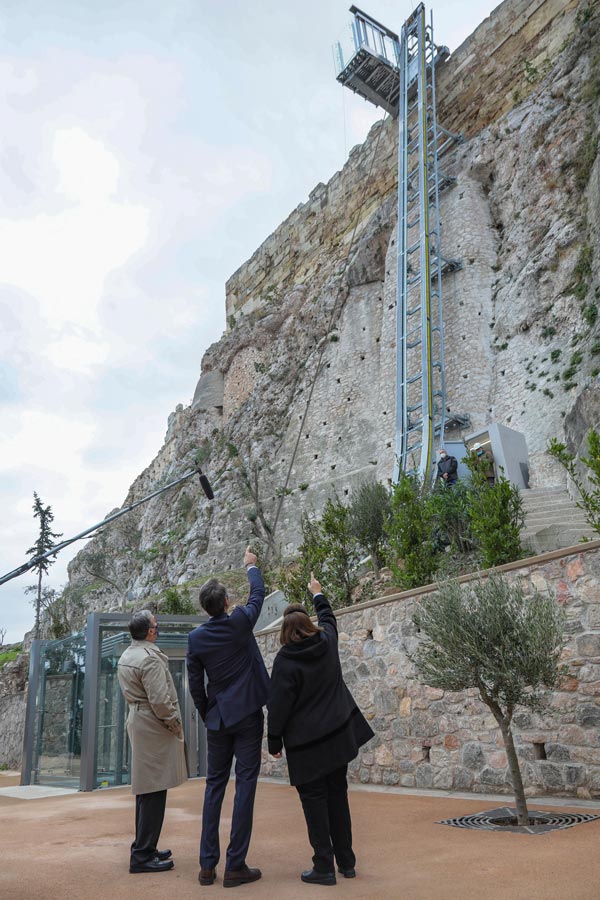
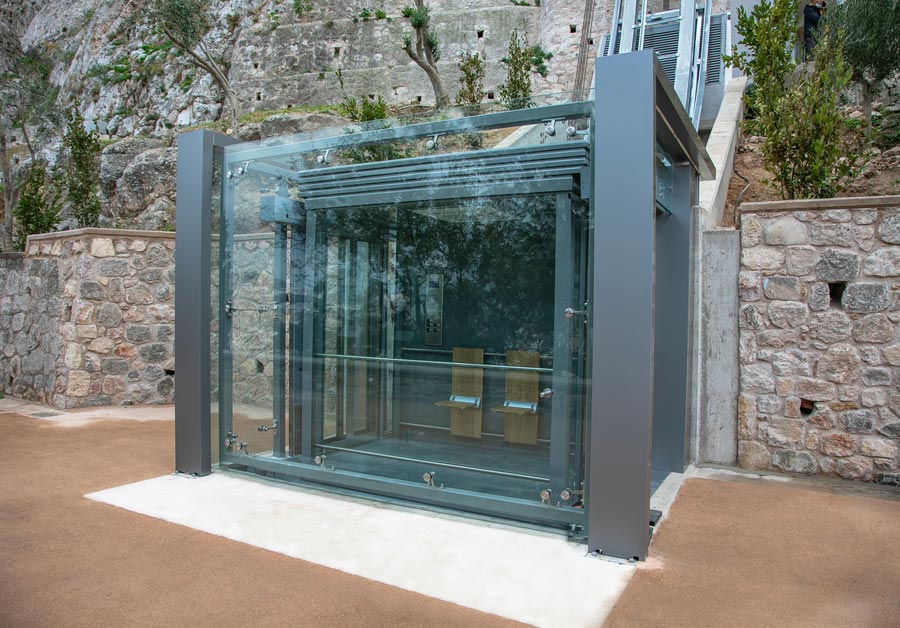



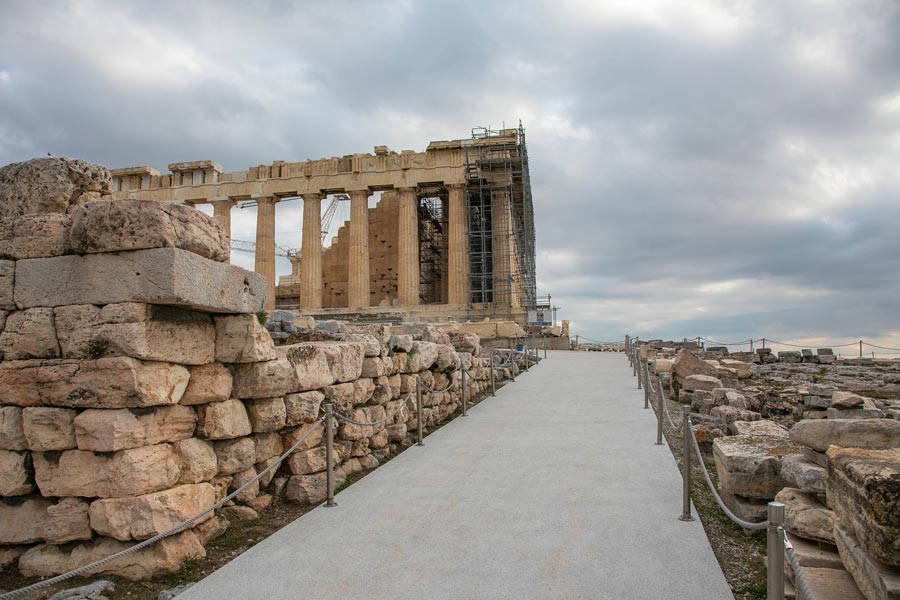

About Maspero Elevatori
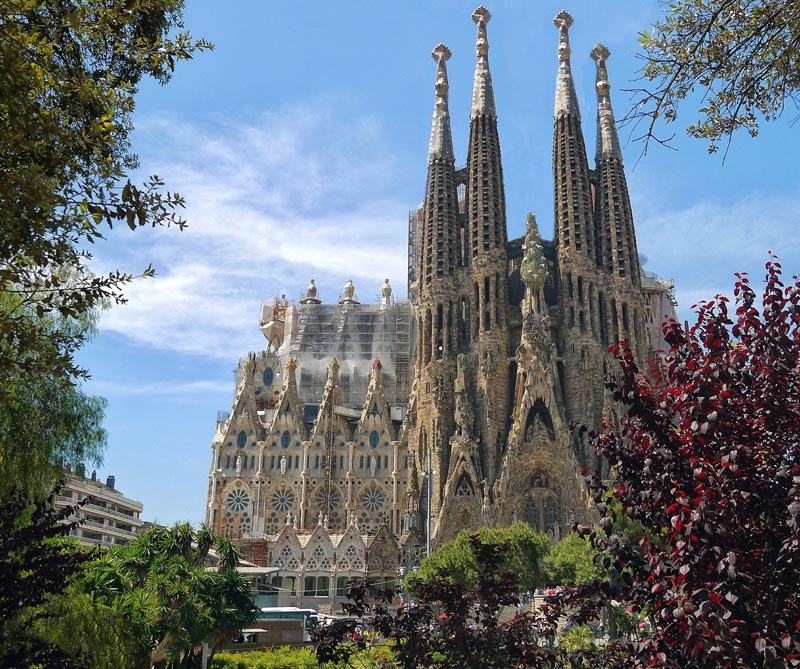
Founded in the early 1960s, Maspero Elevatori is wholly controlled by the Maspero family and has five operational offices in Italy, six foreign branches (Switzerland, Russia, France, the U.K., Iran and India) and 11 strategic partnerships around the world. It operates in the luxury, industry, infrastructure and building segments and prides itself on its ability to understand construction problems each project may present. It studies these problems to produce suitable, tailor-made solutions.
The company invests a substantial portion of its revenue in developing and training a team of highly specialised researchers. Its aim is to create flexible, efficient mobility systems that provide energy savings, comfort and safety. Maspero Elevatori is increasingly involved in developing and managing vertical-transportation equipment serving integrated public mobility systems consistent with new sustainability approaches and linked to the broader “smart city” concept.
For the industrial sector, the company creates hydraulic traction, rack-and-pinion, cable and pantograph systems with load capacities of up to 42,000 kg and travel of up to 300 m.
Maspero Elevatori frequently collaborates with world-renowned architects such as Renzo Piano, Norman Foster and Santiago Calatrava. Among its notable elevator projects are GES-2, the Museum of Contemporary Art in Moscow designed by Piano; the imposing goods lift at the British Museum in London; and the inclined lift serving the Saint-Lazare (Paris Métro). The company is currently involved in the construction of the central elevator of the Sagrada Familia in Barcelona, a Roman Catholic basilica designed by Spanish/Catalan architect Antoni Gaudí (1852–1926).[5]
References
[1] wikipedia.org/wiki/Acropolis_of_Athens
[2] wikipedia.org/wiki/Parthenon
[3] wikipedia.org/wiki/Peripatos_(Akropolis)
[4] ancient.eu/Erechtheion
[5] wikipedia.org/wiki/Sagrada_Fam%C3%ADlia
Get more of Elevator World. Sign up for our free e-newsletter.

